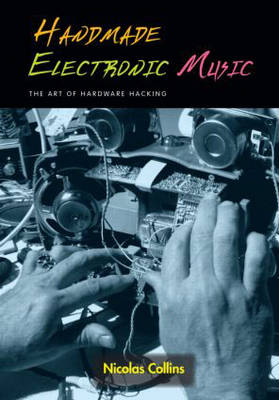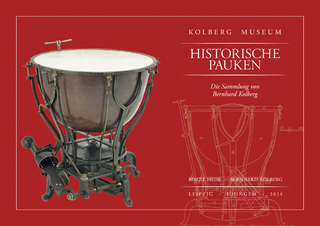
Handmade Electronic Music
Routledge (Verlag)
978-0-415-97592-6 (ISBN)
- Titel ist leider vergriffen;
keine Neuauflage - Artikel merken
Handmade Electronic Music: The Art of Hardware Hacking provides a long-needed, practical, and engaging introduction for students of electronic music, installation and sound-art to the craft of making--as well as creatively cannibalizing--electronic circuits for artistic purposes. Designed for practioners and students of electronic art, it provides a guided tour through the world of electronics, encouraging artists to get to know the inner workings of basic electronic devices so they can creatively use them for their own ends.
Handmade Electronic Music introduces the basic of practical circuitry while instructing the student in basic electronic principles, always from the practical point of view of an artist. It teaches a style of intuitive and sensual experimentation that has been lost in this day of prefabricated electronic musical instruments whose inner workings are not open to experimentation. It encourages artists to transcend their fear of electronic technology to launch themselves into the pleasure of working creatively with all kinds of analog circuitry.
Table of Contents: Part I: Starting Acknowledgements Forward by David Behrman Introduction Chapter 1: Getting Started Tools and materials needed. Chapter 2: The Seven Basic Rules of Hacking General advice. Part II: Listening Chapter 3: Circuit Sniffing Using radios and coils to eavesdrop on hidden electromagnetic music. Sidebar #1: Mortal Coils Chapter 4: In/Out Speaker as microphone, microphone as speaker - the symmetry of it all. Chapter 5: The Celebrated Jumping Speaker of Bowers County Twitching loudspeakers with batteries. Chapter 6: How to Solder An essential skill. Chapter 7: How to Make a Contact Mike Using piezo disks to pick up tiny sounds. Sidebar #2: John Cage - The Father of Invention Sidebar #3: Piezo Music Chapter 8: Turn You Tiny Wall Into a Speaker Resonating objects with piezo disks, transformers and motors. Sidebar #4: David Tudor and Rainforest Sidebar #5: Drivers Chapter 9: Tape Heads Playing credit cards with hand-held tape heads. Sidebar #6: Tape Chapter 10: A Simple Air Mike Cheap condenser mike elements make great microphones. Part III: Touching Chapter 11: Laying of Hands Transforming a portable radio into a synthesizer by making your skin part of the circuit. Sidebar #7: The Crackle Box Chapter 12: Tickle the Clock Finding the clock circuit in toys. Chapter 13: Hack the Clock Changing the clock speed for cool new noises. Sidebar #8: Composing Inside Electronics Chapter 14: Ohm's Law for Dummies How to understand resistors. Chapter 15: Beyond the Pot Photocells, pressure pads, and other ways to control and play your toy. Sidebar #9: Circuit Bending Chapter 16: Switches How to understand different switches, and even make your own. Chapter 17: Jack, Batt & Pack Finishing touches: powering and packaging your hacked toy. Part IV: Building Chapter 18: World's Simplest Oscillator Six oscillators on a 20-cent chip, guaranteed to work. Chapter 19: From Breadboard to Circuit Board How to solder up your first homemade circuit. Chapter 20: More Oscillators Oscillators that modulate each other. Chapter 21: Even More Oscillators Dividers, feedback loops and instability; using oscillators as clocks for toys. Chapter 22: On/Off Gating, ducking, tremolo and panning. Chapter 23: Amplification and Distortion A simple circuit that goes from clean preamp to total distortion. Chapter 24: Analog to Digital Conversion, Sort of Modulating other audio sources with your oscillators. . Part V: Looking Chapter 25: Video Music/Music Video Translating video signals into sound, hacking cheap camera circuits, and extracting sounds from remote controls. Chapter 26: LCD Art Making animated modern daguerreotypes and alternative video projectors. Sidebar #10: Visual Music Part VI: Finishing Chapter 27: Mixers, Matrices and Processing Very simple, very cheap, very clean mixers, and ways of configuring lots of circuits. Chapter 28: A Little Power Amplifier A cheap & simple amplifier. Chapter 29: Analog to Digital Conversion, Really Connecting sensors to computers using game controllers. Sidebar #11: The Luthiers Chapter 30: Power Supplies If you must, here's how to plug into the wall with minimal risk. Appendices Appendix 1: Resources Where to find information and materials. Appendix 2: References and Notes Appendix 3: Inventory What you need to do the projects in this book. Appendix 4: The Rules of Hacking and the Laws of the Avant Garde A recapitulation. Appendix 5: Notes for the audio CD Apppendix 6: Illustration Credits
| Zusatzinfo | 36 Line drawings, black and white; 138 Halftones, black and white |
|---|---|
| Verlagsort | London |
| Sprache | englisch |
| Maße | 178 x 254 mm |
| Gewicht | 476 g |
| Themenwelt | Kunst / Musik / Theater ► Musik ► Instrumentenkunde |
| Technik ► Elektrotechnik / Energietechnik | |
| ISBN-10 | 0-415-97592-1 / 0415975921 |
| ISBN-13 | 978-0-415-97592-6 / 9780415975926 |
| Zustand | Neuware |
| Haben Sie eine Frage zum Produkt? |
aus dem Bereich


